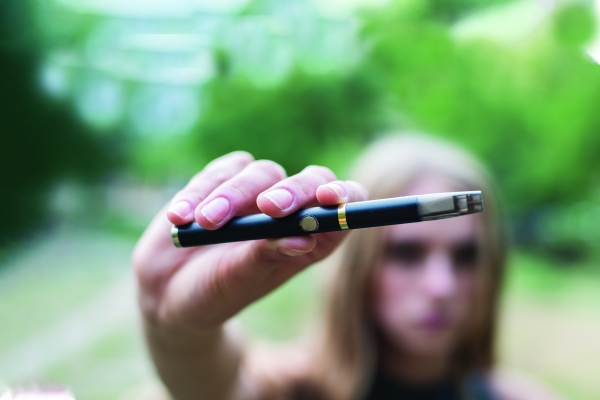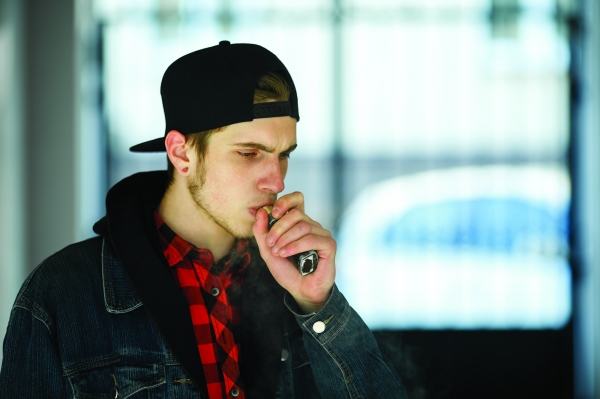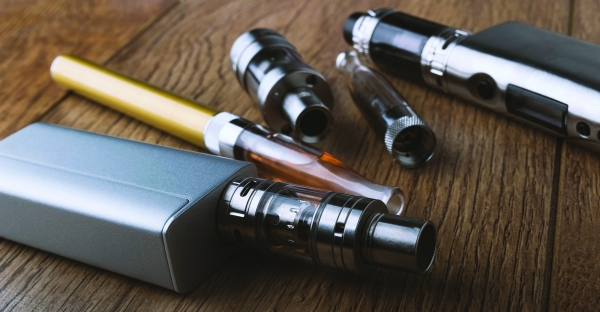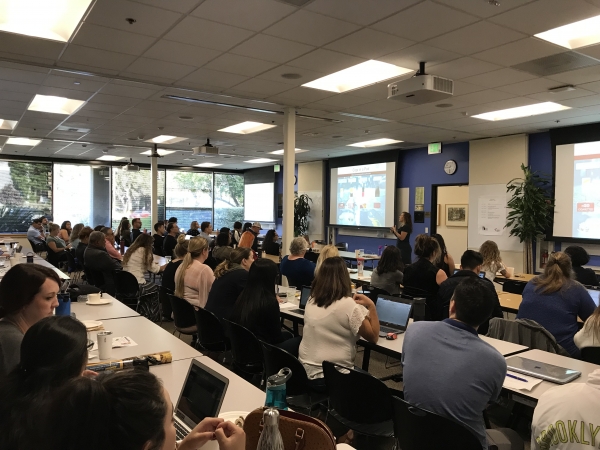Doctors, parents and teachers are increasingly concerned about teenagers using electronic cigarettes and vaping devices, and recent data shows why.
While the cigarette smoking rate is 3.1% among youth ages 14 to 18 in San Mateo and San Francisco counties, 20.8% of teens in those counties vaped in 2018, up from 11.7% in 2017, said Edith Cabuslay, director of the San Mateo County health department's Tobacco Prevention Program, which aims to reduce the number of county residents using tobacco products. The 2018 rate of teens vaping in the county is "alarmingly high" compared with the statewide rate of 10.9% of teens vaping, she said.
With figures showing a steep rise in the use of vaping devices by young people – U.S. Surgeon General Jerome Adams declared vaping an "epidemic" among young people late last year – and a growing outbreak of lung injuries tied to vaping, local schools and government agencies are stepping in to address the problem.
One of the challenges they're facing, however, is a lack of recent data from the Sequoia Union High School District. While districts throughout the state were surveying students on their use of e-cigarettes, alcohol, drugs and tobacco, the Sequoia district, which includes Woodside and Menlo-Atherton high schools and TIDE Academy, quietly transitioned away from administering the surveys. With the help of a recent state grant, the district will return to surveying students this school year.
"Unfortunately, vaping has become a national epidemic," said Sequoia Superintendent Mary Streshly in an email. "The District has used every resource available to develop curriculum, provide professional development and establish partnerships in order to educate our students on the dangers of vaping and to equally enforce that our district does not permit the use of vaping in our schools."
Growing concern
The Centers for Disease Control and Prevention (CDC) is now tracking the outbreak of lung injuries associated with using e-cigarettes – also called vapes, e-hookahs, vape pens, tank systems, mods and electronic nicotine delivery systems, according to the CDC. E-cigarettes are battery-powered devices that work by heating a liquid, which typically contains nicotine or THC, the active ingredient in marijuana, to produce an aerosol that users inhale into their lungs.
Although the effects of vaping are still in the early stages of study, 1,604 lung-injury cases associated with vaping products were reported to the CDC between March 31 and Oct. 22. There have been 34 deaths in 24 states tied to vaping products, according to the agency. Most patients report a history of using products containing THC.
The specific chemicals causing these lung injuries are unknown, and no single product or substance has been linked to all lung-injury cases, according to the CDC.
"The outbreak is occurring in the context of a dynamic marketplace for e-cigarette, or vaping, products, which may have a mix of ingredients, complex packaging and supply chains, and include potentially illicit substances," the CDC reports. "Users may not know what is in their e-cigarette or e-liquid solutions. Many of the products and substances can be modified by suppliers or users. They can be obtained from stores, online retailers, (and) from informal sources such as friends or family members."
Countywide data
County officials plan to meet to assess why the teen vaping rates locally are higher. Cabuslay said she suspects that teens in San Mateo County have an easier time purchasing vaping devices since they often come from families with higher incomes. The marketing for e-cigarette maker Juul may be more prevalent in the area since Stanford University students developed Juul and the company is headquartered in San Francisco, she said.
"To me, the real issue that we should be discussing is the fact that vaping manufacturers go above and beyond to create vaping tools that look like everyday school products, creating additional barriers for schools to combat usage," Streshly said. "We need legislation to outlaw their blatant desire to turn students throughout the nation into long-term dependent consumers."
Surveys of youth often show that vaping usage is actually lower than they expect, and if teens know this it can actually deter vaping, said Javier Gutierrez, the high school district's health and wellness coordinator.
"It helps them better understand it's actually not that many students (who are vaping)," he said. "It reinforces positive decisions; if you find out the majority of people are also not using, you'll feel like you have that community that's on the same side as you."
Missing data
The Sequoia district, which has nearly 9,500 students enrolled, last administered the Healthy Kids Survey during the 2014-15 school year. The survey, used by public school districts throughout the state, includes questions for students on their alcohol, drug and tobacco consumption, as well as questions about vaping. If a school district receives the California Department of Education's Tobacco-Use Prevention Education Program (TUPE) grant, the survey -- which takes about 15 to 30 minutes for students, parents and staff members to complete -- must be administered at least once every two years in grades seven, nine, and 11, according to the survey's website.
"It was a big loss for us as a county not to have (Sequoia's) data included in the countywide pool of data," said Cabuslay. "The survey tries to give us a good picture every two to four years about the health of our different communities. To have one of our biggest high school districts not participate (means) we have to give the caveat that our data doesn't include Sequoia."
The county currently can't give substantive direction to Sequoia leaders about how to handle vaping on its campuses since there isn't data to guide the conversation, she added. (Most local elementary school districts in The Almanac's coverage area last administered their Healthy Kids surveys during the 2017-18 school year.)
The Sequoia district missed the 2017-18 survey cycle because it no longer had the grant, which also helps fund tobacco-specific student instruction, reinforcement activities, events and intervention programs for students, Gutierrez said. The survey can be voluntarily administered by districts if they don't have the grant, but district and school staffers then have to provide their own survey planning, get parent consent and do related administration work, according to the survey's website.
In 2018, the district began to administer the Panorama survey, which focuses more on school climate and culture, engagement and communication. Panorama doesn't include questions about students' alcohol, drug and tobacco consumption.
"The move to the Panorama survey was before my time, but I felt it critical to reintegrate (the Healthy Kids Survey) back into our district, so we are relaunching it this school year," Streshly said.
This fall the state granted the district a three-year TUPE grant totaling $234,000, Gutierrez said. This will help fund administering the Healthy Kids Survey this school year and during the 2021-22 school year, he said. The grant will also help fund peer support and educational prevention programs around tobacco usage.
Local efforts to curb vaping
This school year, the Sequoia district hired intervention counselors for each of its four comprehensive high schools through district funding and through a grant from San Mateo County. These counselors work to support students who are at-risk, as well as those with behavioral, academic or social and emotional struggles, including students who might be vaping or considering vaping, said Gutierrez.
Before the grant funding came through, the district addressed vaping concerns through educational efforts, he said. The district has sent communications to parents about vaping through newsletters starting during the 2017-18 school year, before vaping was even at the forefront of people's minds, he said.
Ninth graders in the district also learn about the "neuroscience of addiction" in their life skills classes, Gutierrez said.
The Sequoia Healthcare District, which provides community-based health care services to local residents, received a $25,000 grant from Breathe California to train high school students about vaping prevention so they could educate fellow students in middle school. The work began last spring, according to Karen Li, director of school health for the health care district.
The Bay Area Community Health Council, a nonprofit focused on eliminating health disparities through education and services, has partnered with Black Student Union (BSU) clubs at Sequoia and Menlo-Atherton high schools to educate African American youth and their peers about the dangers of flavored tobacco products. Youth tend to listen to their peers more than they listen to adults, Shawneece Stevenson, project manager of the nonprofit's tobacco education program, said in an email.
"Our engagement with the BSUs led to them choosing to complete a social justice oriented-tobacco education project," she said. "The project included peer-to-peer education activities, a youth-designed social media campaign called Vape Stops Here, and other advocacy activities such as writing letters to the editor and collecting petitions to restrict the sale of flavored tobacco products in retail stores in Menlo Park, East Palo Alto, and Redwood City."
Last month, the Menlo Park City School District's governing board approved a resolution declaring a public health emergency about the use by young people of e-cigarettes in light of a 2019 National Youth Tobacco Survey that shows that vaping among high school students more than doubled from 2017 to 2019, to 27.5% of students. The resolution expresses the board's support for the efforts by the town of Atherton, the city of Menlo Park and San Mateo County to restrict the sale of tobacco products in order to prevent youth access to vaping devices.
In 2018, the San Mateo County Board of Supervisors passed an ordinance restricting the sale of tobacco products in pharmacies and flavored tobacco products in unincorporated areas, according to the county's website. The ordinance aims to address the increase in vaping among young people.
Menlo Park Mayor Ray Mueller suggested that the City Council consider an ordinance restricting the sale of flavored tobacco products in town at the council's Oct. 15 meeting. He said the proposed ordinance could first come before the council at a Nov. 5 study session.
In September, the San Mateo County Office of Education and Sequoia Healthcare District hosted the Tobacco-Use Prevention Education (TUPE) Summit. During the summit, county educators and community partners learned about strategies to reduce the use of tobacco, vaping and marijuana among students.
During a discussion by a panel of several district students, some participants shared how they took up vaping to fit in with older students. Some explained that they recently quit vaping because of news reports about people dying after using vaping devices.
The Parent Education Series, a Sequoia district program in which experts in subjects like academic success and student well-being discuss their fields with district parents, staff and community members, has held presentations on the risks of vaping.
On Nov. 20, Richard Ceballos, a project coordinator with the Stanford Tobacco Prevention Toolkit, will present a talk, "What's All the Buzz with JUUL & Similar Vape Devices?" at Woodside High School. The toolkit is an online educational resource that can be adapted to fit the individual needs of educators and students in all types of settings, including elementary, middle and high schools; community-based organizations; and health-related agencies.
"The goal (of the Parent Education Series) is always to give parents strategies to educate their kids," said Charlene Margot, founder and director of the Parent Education Series. "I don't want people getting inaccurate data. When they (parents) talk to their kids, we want them to be fully informed. It's not about scare tactics."
-






Comments